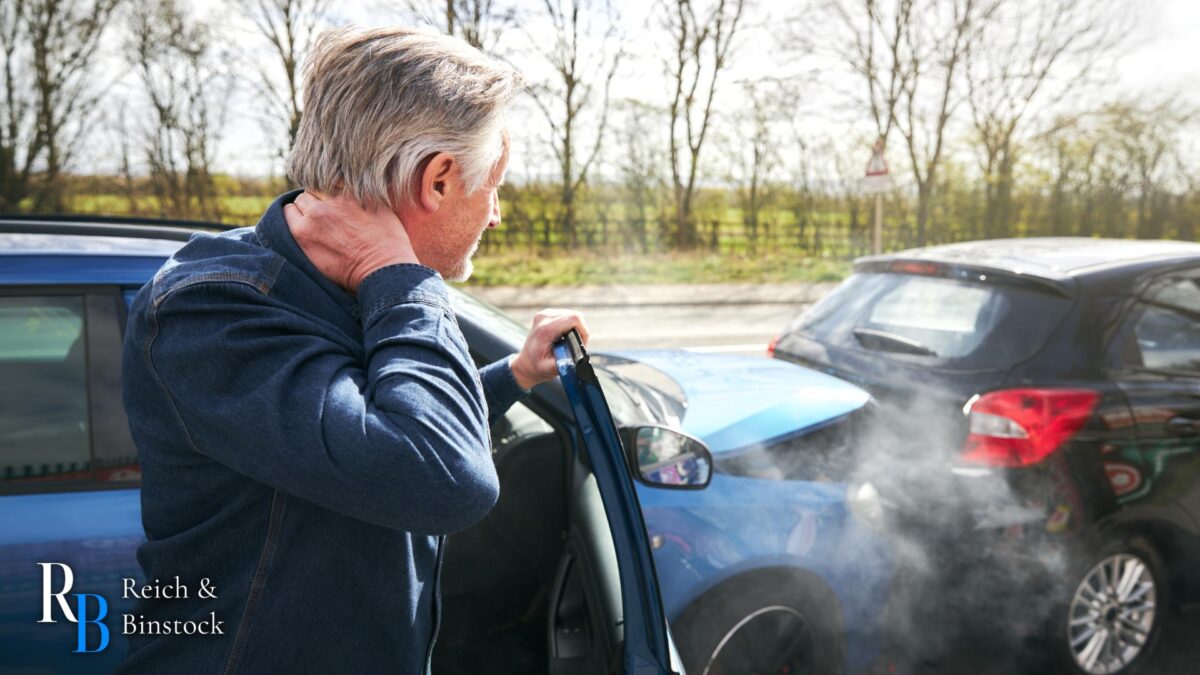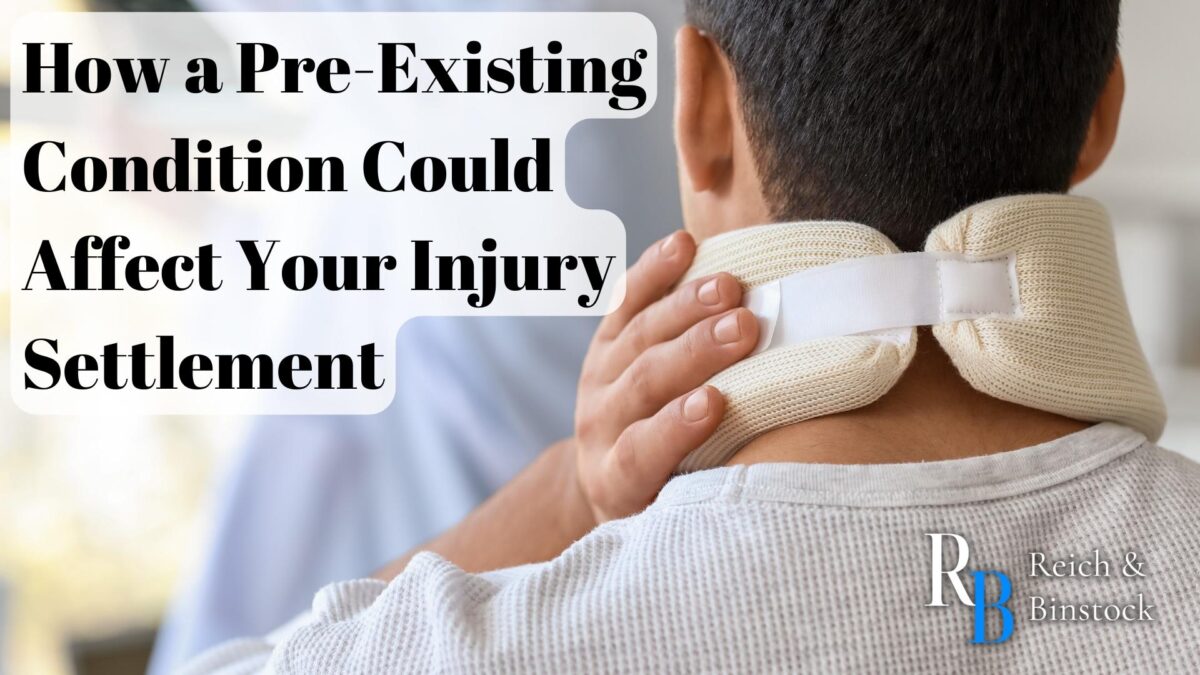When accidents happen, they often lead to injuries, and if you already have a pre-existing condition, it can significantly complicate matters. At Reich & Binstock, we understand the intricate dynamics of navigating personal injury settlements, especially when pre-existing conditions are in the picture. For example, a pre-existing neck injury settlement could look far different from a settlement without a pre-existing condition.
In our newest blog, the Houston personal injury attorneys will shed light on how your pre-existing condition may impact your injury settlement outcome. If you’ve been injured in a car accident and wish to learn more about your legal options, call (713) 622-7271 to schedule a free consultation today.
What Is a Pre-Existing Condition?
According to HealthCare.gov, a pre-existing condition is a medical condition or health issue an individual already has before being involved in a car accident. These conditions vary widely and may include chronic illnesses, previous injuries, or ongoing health concerns such as diabetes, heart disease, asthma, arthritis, or prior surgeries.
In personal injury law, a pre-existing condition can introduce complexity in assessing the cause, extent, and compensation for new injuries sustained in accidents or incidents. Understanding how pre-existing conditions interact with new injuries is crucial in determining liability and the ultimate settlement or legal outcome.
What Are Aggravated Injuries?

An aggravated injury worsens a pre-existing injury following an accident or traumatic event. These pre-existing injuries become aggravated following the accident, leading to increased pain, suffering, and potentially more complicated medical treatment and legal considerations.
Example of an Aggravated Injury
Some examples of aggravated injuries include:
- Back injuries
- Traumatic brain injury (TBI)
- Shoulder injuries
- Prior head injuries
- Knee pain
- Broken bones that haven’t had a chance to heal
- Degenerative disc disease
- Herniated discs
- Arthritis
Common Types of Pre-Existing Conditions or Injuries
The most common types of pre-existing medical conditions that can worsen following a car accident are:
- Degenerative Joint Conditions: Conditions like osteoarthritis, which cause joint degeneration over time, can be exacerbated by an accident or fall.
- Back and Neck Problems: Pre-existing back pain, spinal stenosis, herniated discs, or neck injuries can become more severe after a car crash or slip-and-fall accident.
- Prior Fractures: Individuals with a history of fractures may be at increased risk for re-injury or complications in the event of another fracture.
- Neurological Disorders: Pre-existing neurological conditions, such as epilepsy or multiple sclerosis, can be exacerbated by head injuries or trauma.
- Psychological Conditions: Individuals with prior mental health conditions, like PTSD or depression, may experience worsening symptoms after a traumatic incident.
- Heart and Cardiovascular Issues: Individuals with heart conditions may be at risk for worsening due to the stress or physical strain caused by an accident.
How Can Pre-Existing Injuries Affect Accident Claims?

A pre-existing medical condition can significantly impact personal injury claims, introducing complexities that can affect the outcome of the legal process. One of the primary challenges is establishing causation, as defendants may argue that the pre-existing injury, rather than the accident in question, is responsible for the plaintiff’s condition. This can lead to disputes over liability and the extent of damages. Medical experts may need to differentiate between prior and new injuries, which can further complicate the case.
Pre-existing injuries can have a direct impact on the calculation of damages. The insurance company may argue that the victim’s pain and suffering, medical bills, or lost wages are partially or entirely related to their pre-existing condition, potentially limiting the compensation the claimant can recover. Any specialized or extensive medical treatment after an accident is another consideration, as it can increase the overall cost of the claim.
In some cases, the at-fault party may assert contributory negligence, contending that the victim’s pre-existing condition made them more susceptible to injury, thereby reducing their liability.
How Can You Prove Aggravation of a Pre-Existing Injury?
Proving the aggravation of a pre-existing injury in a personal injury claim can be challenging. Still, it is crucial to establish the connection between the new accident and the worsening of the pre-existing condition. Here are some strategies that your Houston personal injury attorney may use to help prove aggravation:
- Medical Records: Comprehensive medical records, including pre-existing injury and subsequent medical treatment records, are critical. Comparing the victim’s medical history can show the worsening of the pre-existing condition. It should highlight changes in symptoms, diagnostic tests, or treatment plans.
- Documentation of Pain and Disability: Detailed documentation of the victim’s pain, discomfort, and functional limitations before and after the accident is essential. This can include medical notes, diaries, or statements from the victim and healthcare providers.
- Expert Witnesses: Expert witnesses, such as biomechanical engineers or accident reconstructionists, can provide insights into how the accident or incident directly led to the aggravation of the pre-existing injury. Expert medical witnesses can help explain how the new accident exacerbated the pre-existing condition.
- Clear Chronology: Establish a clear timeline of events, emphasizing how the new incident immediately or gradually worsened the pre-existing condition. This timeline should align with medical records and expert testimony.
- Witness Testimony: Eyewitnesses to the accident or individuals who knew the claimant before and after the incident may be able to provide valuable testimony regarding the change in the victim’s condition.
- Photographic and Video Evidence: If available, photographs or videos taken before and after the incident can visually demonstrate the accident’s impact on the victim’s physical condition.
The evidence above can be essential when building a strong case that demonstrates a direct link between the new accident and the worsening of the pre-existing condition to support a successful personal injury claim.
Can I Receive Compensation for Pre-Existing Conditions After an Accident?
Seeking compensation for pre-existing injuries aggravated following an accident is possible but involves navigating a complex legal process. The extent to which your pre-existing condition has been exacerbated due to the accident is crucial.
To pursue compensation, you must establish a clear and documented link between the accident and the worsening of your existing condition. This often requires medical evidence and expert testimony.
It’s highly advisable to retain an experienced personal injury attorney for these cases. They can assess your claim, gather necessary evidence, and develop a strong legal strategy to help you recover compensation.
How a Pre-Existing Condition Could Affect a Settlement

A pre-existing condition can significantly influence the outcome of a settlement in personal injury cases. When an individual already has a medical condition before a motor vehicle accident, it can complicate the claims process.
The insurance company will contend that some portion of the victim’s injuries and medical expenses are related to their pre-existing condition, which can lead to disputes and potentially reduce the settlement amount. Establishing causation and determining the extent to which the accident aggravated the pre-existing condition becomes crucial. A pre-existing condition may impact the overall calculation of damages, including medical costs, pain and suffering, and lost wages.
Pre-Existing Neck Injury Settlement
A claim involving a pre-existing neck injury will most likely make recovering compensation difficult, but it’s not impossible. Neck injuries are a common result of car accidents, and pre-existing neck conditions should not prevent you from compensation. Unfortunately, the defendant’s insurance company will do everything possible to dispute the aggravated injury to pay less of a settlement, so working with an experienced personal injury attorney is critical. They will negotiate with the insurance company on your behalf to ensure they don’t lowball your settlement amount.
Injury settlements differ based on factors like future medical treatments, lost wages, and more. Your attorney from Reich & Binstock will work with medical experts to calculate how much compensation is fair in a claim involving a pre-existing neck injury.
Pre-Existing Back Injury Settlement
Similar to claims involving pre-existing neck injuries, aggravated back injuries following an accident can be just as challenging. Back injuries are another common injury following a car accident, and when an accident victim has a pre-existing condition, back pain can worsen. For example, a person with degenerative disc disease can face long-term consequences following an auto accident.
When you have a prior injury, the at-fault party and insurance company will try to negate your claim to pay a small settlement. At Reich & Binstock, however, our attorneys know that regardless of a pre-existing medical condition, all accident victims deserve compensation for their injuries.
What Is the Deadline for Filing a Personal Injury Claim Involving Pre-Existing Conditions?
The personal injury statute of limitations for filing a claim involving a pre-existing injury is the same as filing one without. In Texas, injury victims have two years to file a claim. That timeline begins on the date the accident occurred.
While two years may seem like a long time, meeting with the personal injury attorneys at Reich & Binstock as soon as possible following an automobile accident is important.
Protect Your Right to Just Compensation After an Accident

If you have a pre-existing condition and have sustained further injuries following a car accident, it’s important to keep the following in mind.
Seek Medical Attention and Get Medical Records
Following the car accident, you must seek medical treatment even if you don’t believe you’ve been severely harmed. The damage to the pre-existing injury may not present itself until days following the accident. However, when you receive medical treatment, the doctor can reference your prior medical records when evaluating current injuries. This can help strengthen your claim that the accident exacerbated your pre-existing condition.
Contact a Personal Injury Attorney
When you contact the personal injury attorneys at Reich & Binstock, it’s vital that you also include details about your pre-existing injury. This will help them prepare for whatever the at-fault party and their insurance company throw at them.
Be Careful What You Tell the Insurance Adjuster
Before contacting your insurance adjuster, reviewing details about the accident and your injuries with your attorney is important. You’ll want to avoid giving them too much information, which can negatively impact your claim and settlement. Your attorney from Reich & Binstock will tell you the information the insurance adjuster will need.
Contact a Houston Personal Injury Lawyer at Reich & Binstock

When you choose Reich & Binstock, you choose a partner who understands the intricacies of personal injury law, who will relentlessly fight for your rights, and who will strive to secure the compensation you deserve. Your physical and financial recovery is our top priority, and we’re here to guide you every step of the way. Choose Reich & Binstock because your peace of mind and future matter to us.
To schedule a free consultation with one of our experienced personal injury attorneys, call (713) 622-7271 today.













